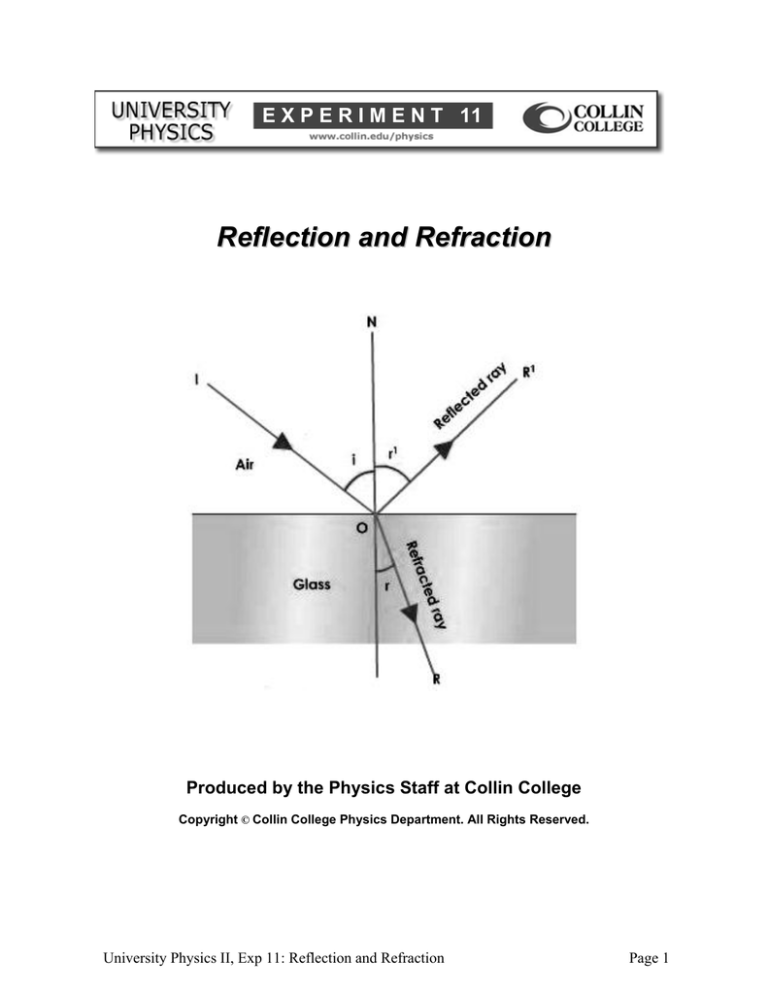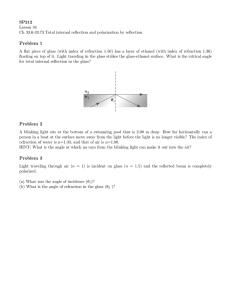
E X P E R I M E N T 11
Reflection and Refraction
Produced by the Physics Staff at Collin College
Copyright © Collin College Physics Department. All Rights Reserved.
University Physics II, Exp 11: Reflection and Refraction
Page 1
Purpose
In this experiment, you will study and verify the laws of reflection and refraction using a
plane mirror and a glass block.
Equipment
Pins
Short candle or similar light source
Pin Board
Rectangular mirror
Sheets of white paper
Thick glass plate
Ruler and protractor
Introduction
Reflection and refraction are two commonly observed optical properties of light. Whenever a
light strikes the surface of some material at an angle, part of the wave is reflected and part is
transmitted (or absorbed). Due to refraction, the velocity of transmitted light is less than the
velocity before it entered the medium. The denser the medium, the more the light is slowed
down. This is due to interaction between the light and the orbiting electrons in the atoms
comprising the material.
The reflection of light rays from a plane surface such as a glass plate or a plane mirror is
described by the law of reflection:
The angle of incidence (θi) is equal to the angle of reflection (θr).
These angles are measured from a line perpendicular
or normal to the reflecting surface (Figure 11.1).
Furthermore, the reflected ray is always in the same
plane as the incident ray, and this plane is
perpendicular to the surface. The rays from an object
reflected by a smooth place surface appear to come
from an image located behind the surface.
For rough surfaces, the law of reflection remains valid.
It predicts that rays incident at slightly different points
on the surface are reflected in completely different
directions, because the normal to a rough surface
varies in direction very strongly from point to point on
the surface. This type of reflection is called diffuse
reflection, and is what enables us to see non-shiny
objects.
University Physics II, Exp 11: Reflection and Refraction
Figure 11.1
Page 2
When light travels from one medium to another, it
generally bends, or refracts as it slows down in the
new medium. Snell’s law (Figure 11.2) states the
relationship between the indices of refraction (n) of
the two materials, and the light’s angle of incidence
and angle of refraction:
n1 sin θ1
n2 sin θ 2
Here n is a measure of the speed of light in a
transparent material and is given by the ratio c/v,
where c is the speed of light in a vacuum and v is
the speed of light in the material.
Figure 11.2
In terms of the indices of refraction and Snell’s law, the following relationships hold true for
refraction:
If the second medium is more optically dense than the first medium (n2 > n1), the
refracted ray will bend toward the normal (θ2 < θ1).
If the second medium is less optically dense than the first medium (n2 < n1), the
refracted ray will bend away from the normal (θ2 > θ1).
Procedure
A. Reflection
Glass Plate as a Mirror
1. Place a sheet of white paper on the pin
board. Draw a center line and place the
glass plate and candle as shown. Draw
the candle line and place a pin in the pin
board where it touches the glass plate.
2. Move your eye to the observing position
so that you see a reflection of the candle
in the glass plate aligned with the pin
you placed. The glass plate partially
reflects the light and serves as a mirror.
You will see a double image, can you
explain why?
3. With your eye still in the observing
position, place another pin in the pin
Figure 11.3
board closer to you so that it is aligned
with the nearer reflected image and first pin. Repeat this procedure, viewing from a
position on the other side of the candle.
4. Remove the equipment from the paper. Draw straight lines through the pair of pin points
to create two image lines (extend through the glass plate). The place where the image lines
University Physics II, Exp 11: Reflection and Refraction
Page 3
cross marks the image position. The place where the candle lines cross should be where
the candle was located and mark the candle object position.
5. Draw normal lines to the glass plate line at the points of intersection of the ray lines. Label
and measure the angles of incidence and reflection. Record the data in Table 11.1.
6. Measure the perpendicular distances from the glass plate line to the candle mark (the
object distance do) and to the candle image position (the image distance di). Calculate the
percent difference in the quantities and record in Table 11.1.
Plane Mirror
1. Place the mirror near the center of a
sheet of paper as with the glass plate
used previously. Prop the mirror up or
use a holder so that its sits vertically.
Draw a line along the reflective silver
side of the mirror. Then lay an object pin
about 10 cm in front of the mirror and
parallel to its length Figure 11.4)
2. Stick a reference pin R in the board to
one side of the object pin and near the
edge of the paper, as illustrated, and
mark its location.
3. Place another pin nearer the mirror so
Figure 11.4
that it is visually aligned with the
reference pin and the head of the object pin’s image in the mirror. Mark the position of
this pin, and label it with an H. Then move this pin over so that it aligns with the reference
pin and the “tail” of the image pin. Mark this location and label it with a T.
4. Repeat this procedure on the opposite side of the object pin with another reference pin.
5. Remove the equipment from the paper and draw straight lines from the reference points
through each of the H and T locations and the mirror line. The H lines and T lines will
intersect and define the locations of the head and tail of the pin image, respectively. Draw
a line between the line intersections (the length of the pin image). Measure the length of
this line and the length of the object pin, and record in Table 11.2. Also measure the object
distance do and the image distance di from the mirror line, and record. Calculate the
percent difference of the respective measured values and record in Table 11.2.
Rotation of a Mirror
1. Place the mirror near the center of a sheet of paper and draw a line along the reflective
silver side of the mirror. Find the center of the line and mark that location.
2. Stick two pins (A and B) in the board to one side and in front of and in line with the center
of the mirror as in Figure 11.5. Viewing the aligned images of these pins from the other
side of the paper, place two more pins (C and D) in alignment. Label the locations of the
pins.
University Physics II, Exp 11: Reflection and Refraction
Page 4
3. Leaving pins A and B in place, rotate
the mirror a small but measurable
angle θ about its center point, and
draw a line along the silvered side of
the mirror. Align two pins (E and F)
with the aligned images of A and B,
and mark and label the locations of E
and F.
4. Remove the equipment from the paper
and draw the incident ray and two
reflected rays. Measure the angle of
rotation θ of the mirror and the angle
of deflection φ between the two
reflected rays, and record in Table
11.3.
Figure 11.5
5. Double θ and compute the percent difference between 2θ and φ and record. Make a
conclusion about the relationship between the angle of rotation of a mirror and the angle
of deflection of a ray.
B. Refraction
Index of Refraction of a Glass Plate
1. Lay the glass plate in the center of a sheet if a paper and outline its shape with a pencil.
Draw a line normal to one of the sides of the plate, and place a pin (R) at the intersection
of this line and the face of the plate. Measure an angle of 15o relative to this line, and
place a pin (A) about 6 to 8 cm from the plate at this angle.
2. Looking through the edge of the plate from the eye positions shown in Figure 11.6, place
a pin (A’) adjacent to the face of the plate so that it is aligned with R and A. Mark and
label the locations of the pins.
3. Repeat with pins B and C at angles
of 30o and 45o, respectively. For
the 45o angle case, align an
additional pin (C’).
4. Trace the various rays, and
measure and record in Table 11.4
the values of θ1 and θ2 for each
case. Also measure and record
the displacement d of ray C’C”
from the normal and the
thickness of the plate. Use Snell’s
law to calculate the index of
refraction of the glass (n).
Compare your calculated value
of n with the general range of n
for glass (1.5 – 1.7 depending on
type).
University Physics II, Exp 11: Reflection and Refraction
Figure 11.6
Page 5



